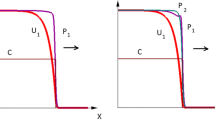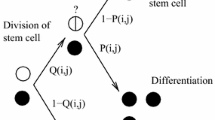Abstract
A novel theory for cell differentiation is proposed, based on simulations with interacting artificial cells which have metabolic networks within, and divide into two when the final product is accumulated. Results of simulations with coupled chemical networks and division process lead to the following scenario of the differentiation: Up to some numbers of cells, divisions bring about almost identical cells with synchronized metabolic oscillations. As the number is increased the oscillations lose the synchrony, leading to groups of cells with different phases of oscillations. At later stage this differentiation is fixed in time, and cells spilt into groups with different chemical constituents spontaneously, which are transmitted to daughter cells by cell divisions. Hierarchical differentiation, origin of stem cells, and anomalous differentiation by transplantations are also discussed with relevance to real biological experimental results.
The authors would like to thank Chris Langton and Howard Gutowitz for useful discussions. This work is partially supported by a Grant-in-Aid for Scientific Research from the Ministry of Education, Science, and Culture of Japan. The authors would like to thank Chris Langton and the members of Santa Fe Institute for their hospitality during their stay, while the paper is completed.
Preview
Unable to display preview. Download preview PDF.
Similar content being viewed by others
References
see e.g., B. Alberts, D.Bray, J. Lewis, M. Raff, K. Roberts, and J.D. Watson, The Molecular Biology of the Cell, 1983
E. Ko, T.Yomo, I. Urabe, Physica 75D (1994) 84
A. Yao and H. Rubin, Proc. Nat. Acad. Sci. 91 (1994) 7712; M. Chow, A. Yao, and H. Rubin, ibid, 91(1994) 599; H. Rubin, ibid, 91(1994) 1039; 91(1994) 6619
K. Kaneko and T. Yomo, Physica 75 D (1994), 89
K. Kaneko, Phys. Rev. Lett. 63 (1989) 219; 65 (1990) 1391; Physica 41 D (1990) 137; Physica 54 D (1991) 5
K. Kaneko, Physica D (1994), 55–73
K. Kaneko, Artificial Life 1, 1994, 163–177
S. Sasa and T. Chawanya, submitted to Phys. Rev. Lett.
K. Kaneko and T. Yomo, “ Dynamic Theory of Differentiation and Development I,II”, in preparation
Author information
Authors and Affiliations
Editor information
Rights and permissions
Copyright information
© 1995 Springer-Verlag Berlin Heidelberg
About this paper
Cite this paper
Kaneko, K., Yomo, T. (1995). A theory of differentiation with dynamic clustering. In: Morán, F., Moreno, A., Merelo, J.J., Chacón, P. (eds) Advances in Artificial Life. ECAL 1995. Lecture Notes in Computer Science, vol 929. Springer, Berlin, Heidelberg. https://doi.org/10.1007/3-540-59496-5_309
Download citation
DOI: https://doi.org/10.1007/3-540-59496-5_309
Published:
Publisher Name: Springer, Berlin, Heidelberg
Print ISBN: 978-3-540-59496-3
Online ISBN: 978-3-540-49286-3
eBook Packages: Springer Book Archive




